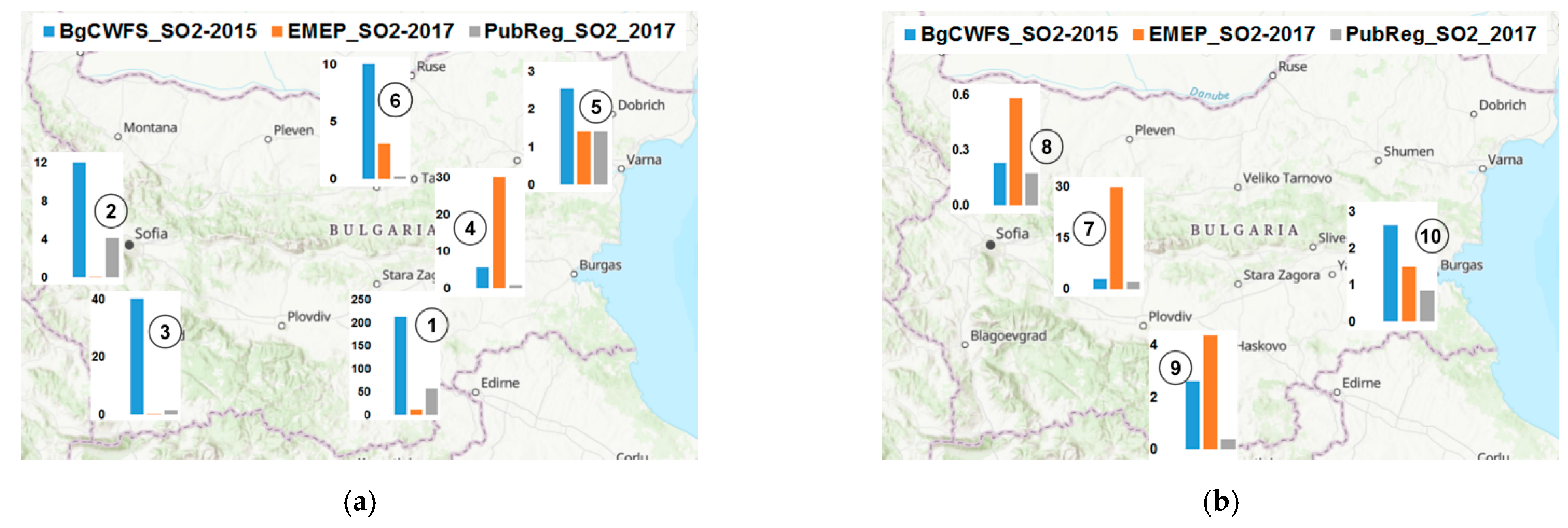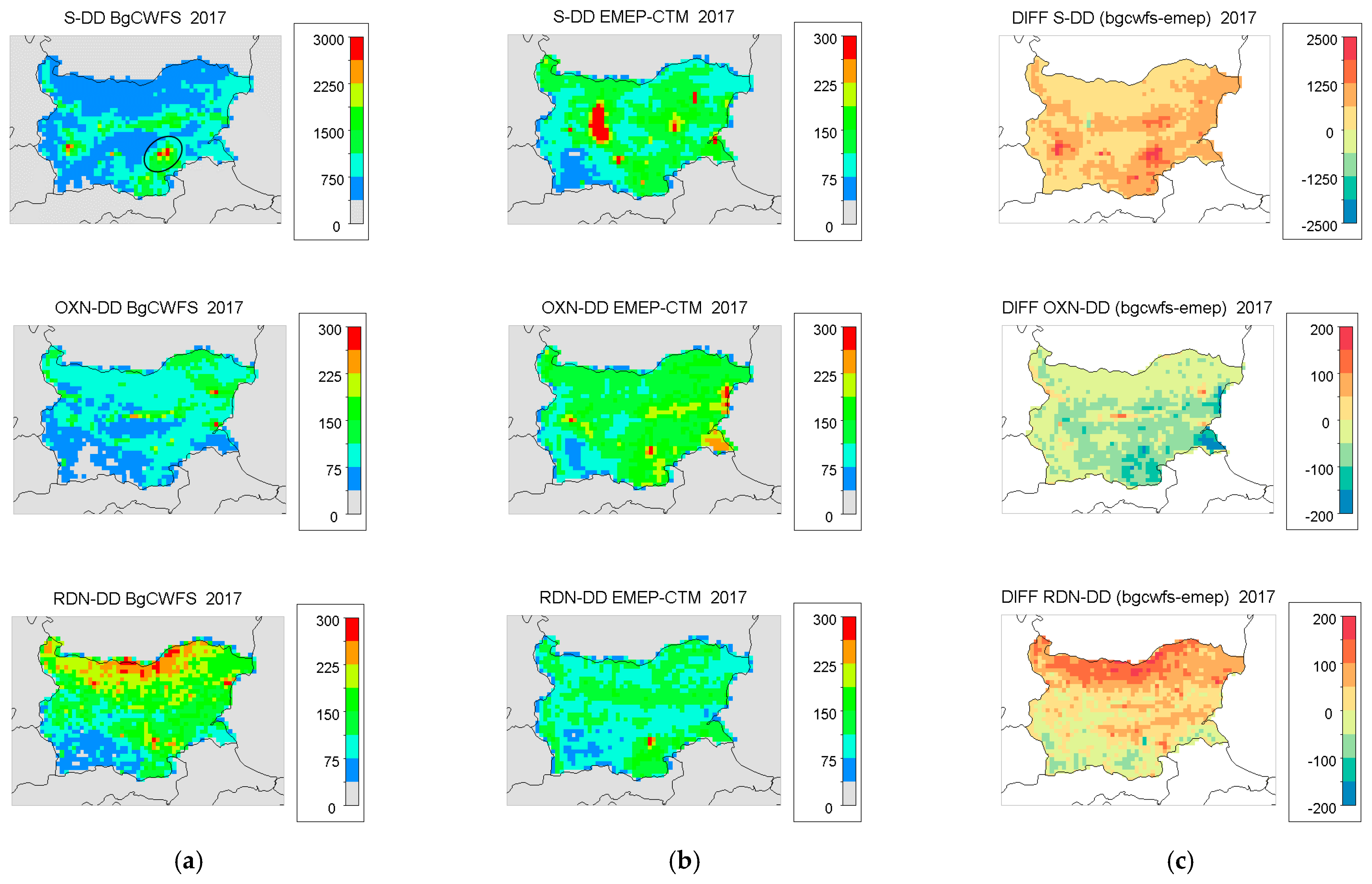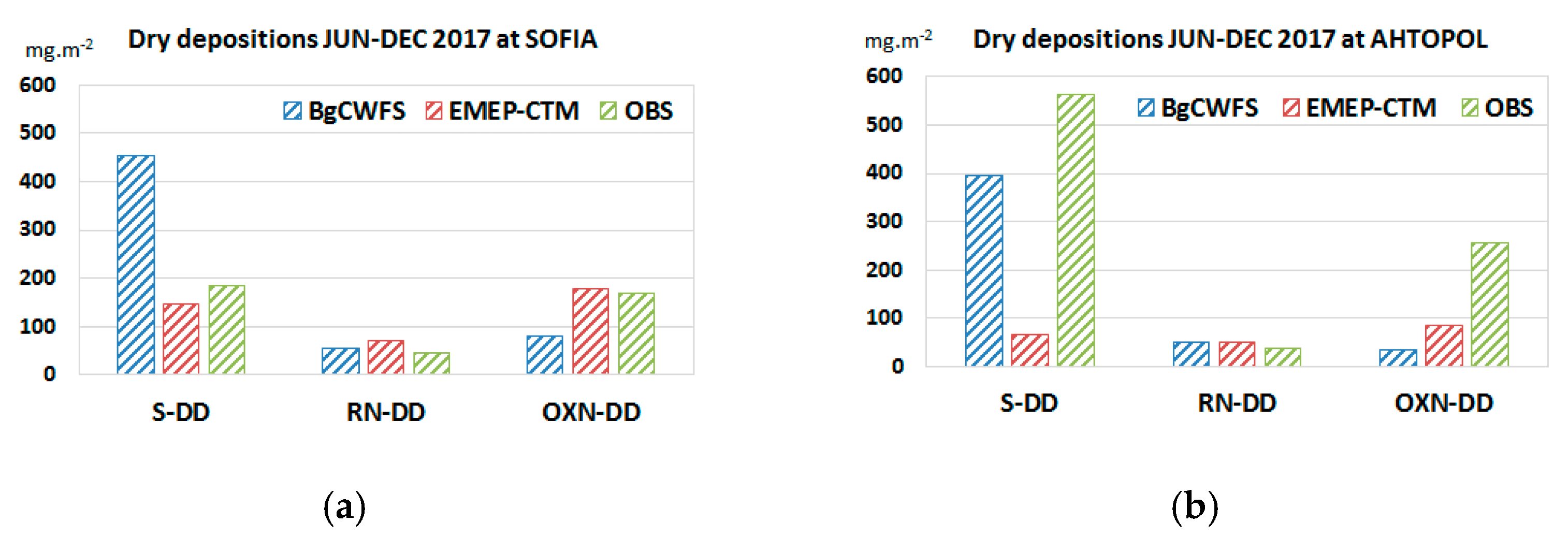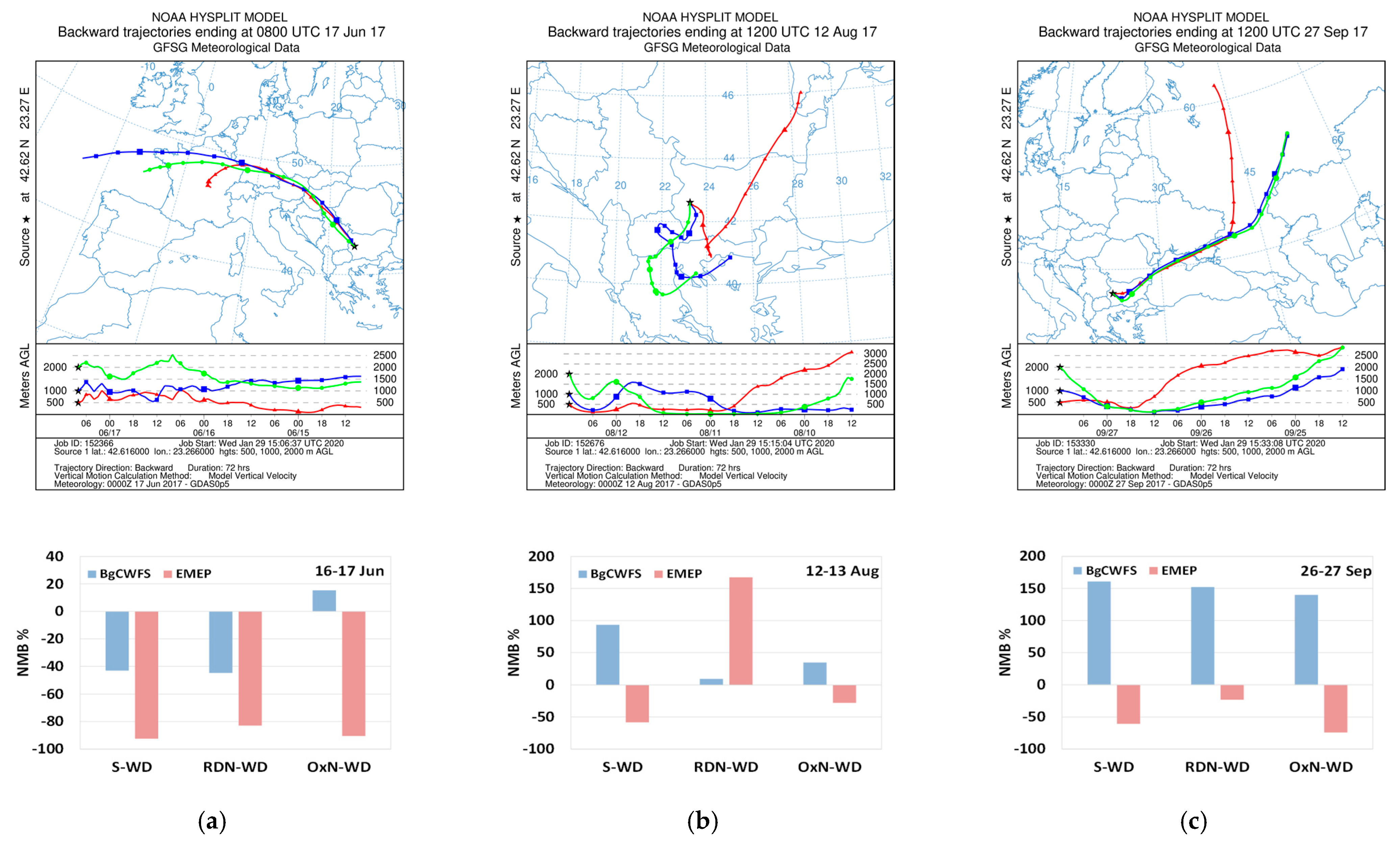Sulfur and Nitrogen Depositions in BULGARIA—Model Results and Observations
Abstract
:1. Introduction
2. Materials and Methods
2.1. The Modeling Systems
2.1.1. Brief Overview of BgCWFS and EMEP-CTM
2.1.2. Emissions
2.2. The Observational Data for Wet and Dry Depositions
2.3. Evaluation of Model Performance
3. Results
3.1. Wet Depositions Modeled by BgCWFS and EMEP-CTM
3.1.1. Precipitation
3.1.2. Domain Mean Wet Depositions
3.1.3. Spatial Distribution of Wet Depositions
3.2. Dry Depositions of Sulfur, Reduced Nitrogen and Oxidized Nitrogen
3.2.1. Domain Mean Dry Depositions
3.2.2. Spatial Distribution of Dry Depositions
3.3. Total Depositions of Sulfur, Reduced Nitrogen and Oxidized Nitrogen
3.4. Comparison to Observed Depositions at Sampling Sites
3.4.1. Chemical Analysis of Precipitation Samples
3.4.2. Comparison to Wet Depositions at Three Sites
3.4.3. Comparison to Dry Depositions at Two Sites
3.5. Effects of Long Range Transport on Depositions at Mountain Site Cherni Vrah
4. Discussion
5. Conclusions
Author Contributions
Funding
Institutional Review Board Statement
Informed Consent Statement
Data Availability Statement
Acknowledgments
Conflicts of Interest
References
- Vet, R.; Artz, R.S.; Carou, S.; Shawa, M.; Ro, C.H.-U.; Aas, W.; Baker, A.; Bowersox, V.C.; Dentener, F.; Galy-Lacaux, C.; et al. A global assessment of precipitation chemistry and deposition of sulphur, nitrogen, sea salt, base cations, organic acids, acidity and pH, and phosphorus. Atmos. Environ. 2014, 93, 3–100. [Google Scholar] [CrossRef]
- Torseth, K.; Aas, W.; Breivik, K.; Fjaeraa, A.M.; Fiebig, M.; Hjellbrekke, A.G.; Lund Myhre, C.; Solberg, S.; Yttri, K.E. Introduction to the European monitoring and evaluation programme (EMEP) and observed atmospheric composition change during 1972–2009. Atmos. Chem. Phys. 2012, 12, 5447–5481. [Google Scholar] [CrossRef] [Green Version]
- Pascaud, A.; Sauvage, S.; Coddeville, P.; Nicolas, M.; Crois, L.; Mezdour, A.; Probst, A. Contrasted spatial and long-term trends in precipitation chemistry and deposition fluxes at rural stations in France. Atmos. Environ. 2016, 146, 28–43. [Google Scholar] [CrossRef] [Green Version]
- Fagerli, H.; Aas, W. Trends of nitrogen in air and precipitation: Model results and observations at EMEP sites in Europe, 1980–2003. Environ. Pollut. 2008, 154, 448–461. [Google Scholar] [CrossRef]
- Fagerli, H.; Tsyro, S.; Simpson, D.; Nyíri, A.; Wind, P.; Gauss, M.; Benedictow, A.; Klein, H.; Valdebenito, A.; Mu, Q.; et al. Transboundary Particulate Matter, Photo-Oxidants, Acidifying and Eutrophying Components; Status Report 1/2021; The Norwegian Meteorological Institute: Oslo, Norway, 2021. [Google Scholar]
- NADP—The US National Atmospheric Deposition Program. Available online: https://nadp.slh.wisc.edu/networks/national-trends-network/ (accessed on 20 January 2022).
- EANET—Acid Deposition Monitoring Network in East Asia. Available online: https://www.eanet.asia (accessed on 20 January 2022).
- Schwede, D.B.; Lear, G.G. A novel hybrid approach for estimating total deposition in the United States. Atmos. Environ. 2014, 92, 207–220. [Google Scholar] [CrossRef] [Green Version]
- Qu, L.; Xiao, H.; Zheng, N.; Zhang, Z.; Xu, Y. Comparison of four methods for spatial interpolation of estimated atmospheric nitrogen deposition in South China. Environ. Sci. Poll. Res. 2017, 24, 2578–2588. [Google Scholar] [CrossRef]
- Schwede, D.B.; Simpson, D.; Tan, J.S.; Dentener, F.; Du, E.; de Vries, W. Spatial variation of modelled total, dry and wet nitrogen deposition to forests at global scale. Environ. Pollut. 2018, 243, 1287–1301. [Google Scholar] [CrossRef]
- Kanakidou, M.; Myriokefalitakis, S.; Daskalakis, N.; Fanourgakis, G.; Nenes, A.; Baker, A.R.; Tsigaridis, K.; Mihalopoulos, N. Past, Present, and Future Atmospheric Nitrogen Deposition. J. Atmos. Sci. 2016, 73, 2039–2047. [Google Scholar] [CrossRef] [Green Version]
- Im, U.; Christodoulaki, S.; Violaki, K.; Zampas, P.; Kocak, M.; Daskalakis, N.; Mihalopoulos, N.; Kanakidou, M. Atmospheric deposition of nitrogen and sulfur over southern Europe with focus on the Mediterranean and the Black Sea. Atmos. Environ. 2013, 81, 660–670. [Google Scholar] [CrossRef]
- Dentener, F.J.; Drevet, J.; Lamarque, J.F.; Bey, I.; Eickhout, B.; Fiore, A.M.; Hauglustaine, D.; Horowitz, L.W.; Krol, M.; Kulshrestha, U.C.; et al. Nitrogen and sulfur deposition on regional and global scales: A multimodel evaluation. Glob. Biogeochem 2006, 20, GB4003. [Google Scholar] [CrossRef]
- Theobald, M.R.; Vivanco, M.G.; Aas, W.; Andersson, C.; Ciarelli, G.; Couvidat, F.; Cuvelier, K.; Manders, A.; Mircea, M.; Pay, M.-T.; et al. An evaluation of European nitrogen and sulfur wet deposition and their trends estimated by six chemistry transport models for the period 1990–2010. Atmos. Chem. Phys. 2019, 19, 379–405. [Google Scholar] [CrossRef] [Green Version]
- Vivanco, M.G.; Theobald, M.R.; García-Gómez, H.; Garrido, J.L.; Prank, M.; Aas, W.; Adani, M.; Alyuz, U.; Andersson, C.; Bellasio, R.; et al. Modeled deposition of nitrogen and sulfur in Europe estimated by 14 air quality model systems: Evaluation, effects of changes in emissions and implications for habitat protection. Atmos. Chem. Phys. 2018, 18, 10199–10218. [Google Scholar] [CrossRef] [PubMed] [Green Version]
- Aas, W.; Artz, R.; Bowersox, V.; Carmichael, G.; Cole, A.; Dentener, F.; Fagerli, H.; Gay, D.; Geddes, J.; Hogrefe, C.; et al. Global Atmosphere Watch Workshop on Measurement-Model Fusion for Global Total Atmospheric Deposition; Carou, S., Vet, R., Eds.; GAW Report No. 234; World Meteorological Organization: Geneva, Switzerland, 2017. [Google Scholar]
- Zhang, Y.; Foley, K.M.; Schwede, D.B.; Bash, J.O.; Pinto, J.P.; Dennis, R.L. A Measurement-Model Fusion Approach for Improved Wet Deposition Maps and Trends. J. Geophys. Res. Atmos. 2019, 124, 4237–4251. [Google Scholar] [CrossRef] [PubMed] [Green Version]
- Andersson, C.; Alpfjord, W.H.; Engardt, M. Long-term sulfur and nitrogen deposition in Sweden: 1983–2013 reanalysis. SMHI Meteorol. 2018, 163, 102. [Google Scholar]
- Aas, W.; Artz, R.; Bowersox, V.; Carmichael, G.; Cole, A.; Dentener, F.; Geddes, J.; Stein, A.; Schwede, D.; Galmarini, S.; et al. Global Atmosphere Watch Expert Meeting on Measurement-Model Fusion for Global Total Atmospheric Deposition; Labrador, L., Vet, R., Eds.; GAW Report No. 250; World Meteorological Organization: Geneva, Switzerland, 2019. [Google Scholar]
- Vivanco, M.G.; Bessagnet, B.; Cuvelier, C.; Theobald, M.R.; Tsyro, S.; Pirovano, G.; Aulinger, A.; Bieser, J.; Calori, G.; Ciarelli, G. Joint analysis of deposition fluxes and atmospheric concentrations of inorganic nitrogen and sulphur compounds predicted by six chemistry transport models in the frame of the EURODELTAIII project. Atmos. Environ. 2017, 151, 152–175. [Google Scholar] [CrossRef] [Green Version]
- Galmarini, S.; Makar, P.; Clifton, O.E.; Hogrefe, C.; Bash, J.O.; Bellasio, R.; Bianconi, R.; Bieser, J.; Butler, T.; Ducker, J.; et al. Technical note: AQMEII4 Activity 1: Evaluation of wet and dry deposition schemes as an integral part of regional-scale air quality models. Atmos. Chem. Phys. 2021, 21, 15663–15697. [Google Scholar] [CrossRef]
- UNEP Convention on Biological Diversity, Country Profile, Bulgaria. Available online: https://www.cbd.int/countries/profile/?country=bg#facts (accessed on 21 January 2022).
- Digital Observatory of Protected Areas, EC-JRC Protected Area Explorer. Available online: https://dopa.jrc.ec.europa.eu/dopa/ (accessed on 21 January 2022).
- Gadzhev, G.; Ivanov, V. Modelling of the Seasonal Sulphur and Nitrogen Depositions over the Balkan Peninsula by CMAQ and EMEP-MSC-W. In Studies in Systems, Decision and Control, Environmental Protection and Disaster Risks. EnviroRISK 2020; Dobrinkova, N., Gadzhev, G., Eds.; Springer: Cham, Switzerland, 2021; Volume 361, pp. 171–183. [Google Scholar] [CrossRef]
- Syrakov, D.; Prodanova, M.; Georgieva, E.; Hristova, E. Applying WRF-CMAQ models for assessment of sulphur and nitrogen deposition in Bulgaria for years 2016 and 2017. Intern. J. Env. Pollut. 2019, 66, 162–186. [Google Scholar] [CrossRef]
- Klein, H.; Gauss, M.; Tsyro, S.; Nyíri, Á.; Fagerli, H. Transboundary Air Pollution by Sulphur, Nitrogen, Ozone and Particulate Matter in 2019, Country Report Bulgaria, MSC-W Data Note 1/2021. Available online: https://emep.int/mscw/mscw_publications.html (accessed on 21 January 2022).
- Iordanova, L. Local and advective characteristics of the precipitations’ chemical composition in Sofia, Bulgaria. Compt. Rend. Acad. Bulg. Sci. 2010, 63, 295–302. [Google Scholar]
- Hristova, E. Chemical composition of precipitation in urban area. Bul. J. Meteotol. Hydro 2017, 22, 41–49. Available online: http://meteorology.meteo.bg/global-change/content-en-22-1-2.html (accessed on 21 January 2022).
- Georgieva, E.; Hristova, E.; Syrakov, D.; Prodanova, M.; Batchvarova, E. Preliminary evaluation of CMAQ modelled wet deposition of sulphur and nitrogen over Bulgaria. Int. J. Environ. Pollut. 2018, 64, 161–177. [Google Scholar] [CrossRef]
- Oruc, I.; Georgieva, E.; Hristova, E.; Velchev, K.; Demir, G.; Akkoyunlu, B.O. Wet Deposition in the Cross-Border Region between Turkey and Bulgaria: Chemical Analysis in View of Cyclone Paths. Bull. Environ. Contam. Toxicol. 2021, 106, 812–818. [Google Scholar] [CrossRef] [PubMed]
- Syrakov, D.; Georgieva, E.; Prodanova, M.; Hristova, E.; Gospodinov, I.; Slavov, K.; Veleva, B. Application of WRF-CMAQ Model System for Analysis of Sulfur and Nitrogen Deposition over Bulgaria. In Numerical Methods and Applications. NMA 2018; Lecture Notes in Computer Science; Nikolov, G., Kolkovska, N., Georgiev, K., Eds.; Springer: Cham, Switzerland, 2019; Volume 11189, pp. 474–482. [Google Scholar] [CrossRef]
- Simpson, D.; Benedictow, A.; Berge, H.; Bergström, R.; Emberson, L.D.; Fagerli, H.; Flechard, C.R.; Hayman, G.D.; Gauss, M.; Jonson, J.E.; et al. The EMEP MSC-W chemical transport model– technical description. Atmos. Chem. Phys. 2012, 12, 7825–7865. [Google Scholar] [CrossRef] [Green Version]
- EMEP Publications from MSC-W. The Norwegian Meteorological Institute, Oslo, Norway. Available online: https://www.emep.int/mscw/mscw_publications.html (accessed on 21 January 2022).
- EMEP MSC-W Modelled Air Concentrations and Depositions. Available online: https://emep.int/mscw/mscw_moddata.html (accessed on 21 January 2022).
- Skamarock, W.C.; Klemp, J.B. A time-split non-hydrostatic atmospheric model. J. Comput. Phys. 2008, 227, 3465–3485. [Google Scholar] [CrossRef]
- Byun, D.; Schere, K.L. Review of the Governing Equations, Computational Algorithms and Other Components of the Models-3 Community Multiscale Air Quality (CMAQ) Modeling System. Appl. Mech. Rev. 2006, 59, 51–77. [Google Scholar] [CrossRef]
- Syrakov, D.; Prodanova, M.; Etropolska, I.; Slavov, K.; Ganev, K.; Miloshev, N.; Ljubenov, T. A multi-domain operational chemical weather forecast system. In LSSC 2013: Large-Scale Scientific Computing; Lirkov, I., Margenov, S., Waśniewski, J., Eds.; Springer: Berlin/Heidelberg, Germany, 2013; Volume 8353, pp. 413–420. [Google Scholar] [CrossRef]
- BgCWFS (Bulgarian Chemical Weather Forecast System). Available online: http://info.meteo.bg/cw2.1/ (accessed on 21 January 2022).
- Kuenen, J.J.P.; Visschedijk, A.J.H.; Jozwicka, M.; van der Gon Denier, H.A.C. TNO-MACC II emission inventory; a multi-year (2003–2009) consistent high resolution European emission inventory for air quality modelling. Atmos. Chem. Phys. 2014, 14, 10963–10976. [Google Scholar] [CrossRef] [Green Version]
- Hong, S.-Y.; Noh, Y.; Dudhia, J. A new vertical diffusion package with an explicit treatment of entrainment processes. Mon. Wea. Rev. 2006, 134, 2318–2341. [Google Scholar] [CrossRef] [Green Version]
- Hong, S.-Y.; Lim, J.-O.J. The WRF single-moment 6-class microphysics scheme (WSM6). J. Korean Meteor. Soc. 2006, 42, 129–151. [Google Scholar]
- Kain, J.S. The Kain-Fritsch convective parameterization: An update. J. Appl. Meteor. 2004, 43, 170–181. [Google Scholar] [CrossRef] [Green Version]
- Chen, F.; Dudhia, J. Coupling an advanced land-surface/ hydrology model with the Penn State/ NCAR MM5 modeling system. Part I: Model description and implementation. Mon. Wea. Rev. 2011, 129, 569–585. [Google Scholar] [CrossRef] [Green Version]
- Pleim, J.; Xiu, A.; Finkelstein, P.L.; Otte, T.L. A coupled land-surface and dry deposition model and comparison to field measurements of surface heat, moisture, and ozone fluxes. Water Air Soil Pollut. Focus 2001, 1, 243–252. [Google Scholar] [CrossRef]
- Foley, K.M.; Roselle, S.J.; Appel, K.W.; Bhave, P.V.; Pleim, J.E.; Otte, T.L.; Mathur, R.; Sarwar, G.; Young, O.J.; Gilliam, C.G.; et al. Incremental testing of the Community Multiscale Air Quality (CMAQ) modeling system version 4.7. Geosci. Model Dev. 2010, 3, 205–226. [Google Scholar] [CrossRef] [Green Version]
- Appel, K.W.; Foley, K.M.; Bash, J.O.; Pinder, R.W.; Dennis, R.L.; Allen, D.J.; Pickering, K. A multi-resolution assessment of the Community Multiscale Air Quality (CMAQ) model v4.7 wet deposition estimates for 2002–2006. Geosci. Model Dev. 2011, 4, 357–371. [Google Scholar] [CrossRef] [Green Version]
- Cressman, G.P. An operational objective analysis system. Mon. Weather Rev. 1959, 87, 367–374. [Google Scholar] [CrossRef]
- Simpson, D.; Bergström, R.; Tsyro, S.; Wind, P. Updates to the EMEP MSC-W model, 2018–2019. In Transboundary Particulate Matter, Photo Oxidants, Acidifying and Eutrophying Components; EMEP Status Report 1/2019; The Norwegian Meteorological Institute: Oslo, Norway, 2019; pp. 145–155. [Google Scholar]
- Gaisbauer, S.; Wankmüller, R.; Matthews, B.; Mareckova, K.; Schindlbacher, S.; Sosa, C.; Tista, M.; Ullrich, B. Emissions in 2017. In Transboundary Particulate Matter, Photo-Oxidants, Acidifying and Eutrophying Components; EMEP Status Report 1/2019; The Norwegian Meteorological Institute: Oslo, Norway, 2019; pp. 43–64. [Google Scholar]
- EMEP/CEIP: EMEP Centre on Emission Inventories and Projections. Reported Emission Data. Available online: https://www.ceip.at/webdab-emission-database/reported-emissiondata (accessed on 20 January 2022).
- EPRTR: European Pollutant Release and Transfer Register. Available online: https://prtr.eea.europa.eu/#/home (accessed on 20 January 2022).
- Fioletov, V.; McLinden, C.A.; Krotkov, N.; Li, C.; Joiner, J.; Theys, N.; Carn, S.; Moran, M.D. A global catalogue of large SO2 sources and emissions derived from the Ozone Monitoring Instrument. Atmos. Chem. Phys. 2016, 16, 11497–11519. [Google Scholar] [CrossRef] [Green Version]
- Fioletov, V.; McLinden, C.; Krotkov, N.; Li, C.; Leonard, P.; Joiner, J.; Carn, S. Multi-Satellite Air Quality Sulfur Dioxide (SO2) Database Long-Term L4 Global V1; Leonard, P., Ed.; Goddard Earth Science Data and Information Services Center (GES DISC): Greenbelt, MD, USA, 2019. [Google Scholar] [CrossRef]
- Allan, M.A. (Ed.) Manual for the GAW Precipitation Chemistry Programme; GAW Report No. 160; World Meteorological Organization: Geneva, Switzerland, 2004. [Google Scholar]
- Gauss, M.; Tsyro, S.; Fagerli, H.; Hjellbrekke, A.G.; Aas, W. 2019: Acidifying and Eutrophying Components, Supplementary Material to EMEP Status Report 1/2019; The Norwegian Meteorological Institute: Oslo, Norway, 2019; Available online: https://www.emep.int/mscw/mscw_publications.html#2019 (accessed on 20 January 2022).
- Tyrlis, E.; Lelieveld, J. Climatology and dynamics of the summer Etesian winds over the Eastern Mediterranean. J. Atmos. Sci. 2013, 70, 3374–3396. [Google Scholar] [CrossRef]
- Stein, A.F.; Draxler, R.R.; Rolph, G.D.; Stunder, B.J.B.; Cohen, M.D.; Ngan, F. NOAA’s HYSPLIT atmospheric transport and dispersion modeling system. Bull. Amer. Meteor. Soc. 2015, 96, 2059–2077. [Google Scholar] [CrossRef]
- Rolph, G.; Stein, A.; Stunder, B. Real-time Environmental Applications and Display sYstem: READY. Environ. Model. Softw. 2017, 95, 210–228. [Google Scholar] [CrossRef]
- Ivanov, V.; Gadzhev, G.; Ganev, K. Modelling of dry and wet deposition processes for the sulphur and nitrogen compounds over Bulgaria. In Proceedings of the International Conference on Harmonisation within Atmospheric Dispersion Modelling for Regulatory Purposes, Tartu, Estonia, 14–18 June 2021; Available online: www.hramo.org (accessed on 20 January 2022).
- Georgieva, E.; Kirova, H.; Hristova, E. Atmospheric Dry Depositions in the Southern Bulgarian Black Sea Coastal Area during Summer. In Proceedings of the 21st International Multidisciplinary Scientific GeoConference (SGEM2021), Albena, Bulgaria, 14–22 August 2021. in press. [Google Scholar]












| BG | EU-27 | |||||
|---|---|---|---|---|---|---|
| 2015 1 | 2016 2 | 2017 2 | 2011 1 | 2016 2 | 2017 2 | |
| SOx | 142 | 105 | 103 | 3963 | 2219 | 2177 |
| NOx | 116 | 110 | 100 | 9184 | 7695 | 7542 |
| NH3 | 45 | 46 | 45 | 3805 | 3869 | 3885 |
| Site Numbers | Large Point Sources of SOx Emissions in Bulgaria | BgCWFS 2015 | EMEP-CTM 2017 | EPRTR 2017 | OMI 2017 |
|---|---|---|---|---|---|
| 1 | TPP complex “Maritza East” | 212.2 | 9.8 | 56.7 | 169 |
| 2 | TPP Republika | 12.0 | 0 | 4.1 | |
| 3 | TPP Bobov Dol | 41.4 | 0.1 | 1.5 | 44 |
| 4 | TPP Sliven | 5.7 | 32.8 | 0.9 | |
| 5 | TPP Deven | 2.5 | 1.4 | 1.4 | |
| 6 | TPP Ruse | 12.9 | 3.1 | 0.2 | |
| 7 | Aurubis copper production | 2.9 | 29.6 | 2.0 | |
| 8 | Holcim cement plant | 0.2 | 0.6 | 0.2 | |
| 9 | KCM non-ferrous metal production | 2.6 | 4.4 | 0.4 | |
| 10 | Lukoil Neftochim refinery | 2.6 | 1.5 | 0.8 |
| PR (mm) 2016 | PR (mm) 2017 | |||
|---|---|---|---|---|
| Mean | Max | Mean | Max | |
| observed | 737 | 2429 | 809 | 2404 |
| BgCWFS | 736 | 2389 | 877 | 2243 |
| EMEP | 773 | 1830 | 769 | 1605 |
| Domain Mean Quarterly PR (mm) 2016 | Domain Mean Quarterly PR (mm) 2017 | |||||||
|---|---|---|---|---|---|---|---|---|
| JFM | AMJ | JAS | OND | JFM | AMJ | JAS | OND | |
| observed | 234 | 254 | 112 | 137 | 162 | 232 | 167 | 248 |
| BgCWFS | 204 | 296 | 86 | 150 | 203 | 270 | 150 | 254 |
| EMEP | 246 | 263 | 122 | 142 | 150 | 228 | 155 | 236 |
| Wet Depositions (mg·m−2) 2016 | Wet Depositions (mg·m−2) 2017 | ||||||
|---|---|---|---|---|---|---|---|
| Period | Model | S | RDN | OXN | S | RDN | OXN |
| JFM | BgCWFS | 224 | 55 | 22 | 213 | 55 | 25 |
| EMEP | 113 | 59 | 23 | 105 | 67 | 23 | |
| AMJ | BgCWFS | 319 | 89 | 21 | 383 | 95 | 24 |
| EMEP | 118 | 85 | 35 | 115 | 90 | 37 | |
| JAS | BgCWFS | 163 | 31 | 16 | 210 | 41 | 16 |
| EMEP | 64 | 71 | 32 | 90 | 71 | 32 | |
| OND | BgCWFS | 177 | 40 | 28 | 268 | 52 | 22 |
| EMEP | 61 | 34 | 29 | 119 | 42 | 32 | |
| Annual | BgCWFS | 883 | 215 | 87 | 1076 | 243 | 87 |
| EMEP | 356 | 249 | 119 | 429 | 270 | 124 | |
| Dry Depositions (mg·m−2) 2016 | Dry Depositions–(mg·m−2) 2017 | ||||||
|---|---|---|---|---|---|---|---|
| Period | Model | S | RDN | OXN | S | RDN | OXN |
| JFM | BgCWFS | 313 | 27 | 22 | 271 | 30 | 25 |
| EMEP | 28 | 23 | 22 | 29 | 25 | 23 | |
| AMJ | BgCWFS | 167 | 43 | 21 | 174 | 49 | 24 |
| EMEP | 27 | 25 | 35 | 27 | 26 | 37 | |
| JAS | BgCWFS | 109 | 35 | 16 | 113 | 40 | 16 |
| EMEP | 21 | 33 | 32 | 25 | 33 | 32 | |
| OND | BgCWFS | 245 | 37 | 28 | 199 | 29 | 22 |
| EMEP | 30 | 23 | 29 | 31 | 24 | 32 | |
| Annual | BgCWFS | 834 | 142 | 87 | 757 | 148 | 87 |
| EMEP | 106 | 104 | 118 | 112 | 108 | 124 | |
Publisher’s Note: MDPI stays neutral with regard to jurisdictional claims in published maps and institutional affiliations. |
© 2022 by the authors. Licensee MDPI, Basel, Switzerland. This article is an open access article distributed under the terms and conditions of the Creative Commons Attribution (CC BY) license (https://creativecommons.org/licenses/by/4.0/).
Share and Cite
Georgieva, E.; Hristova, E.; Syrakov, D.; Prodanova, M.; Gospodinov, I.; Veleva, B. Sulfur and Nitrogen Depositions in BULGARIA—Model Results and Observations. Atmosphere 2022, 13, 343. https://doi.org/10.3390/atmos13020343
Georgieva E, Hristova E, Syrakov D, Prodanova M, Gospodinov I, Veleva B. Sulfur and Nitrogen Depositions in BULGARIA—Model Results and Observations. Atmosphere. 2022; 13(2):343. https://doi.org/10.3390/atmos13020343
Chicago/Turabian StyleGeorgieva, Emilia, Elena Hristova, Dimiter Syrakov, Maria Prodanova, Ilian Gospodinov, and Blagorodka Veleva. 2022. "Sulfur and Nitrogen Depositions in BULGARIA—Model Results and Observations" Atmosphere 13, no. 2: 343. https://doi.org/10.3390/atmos13020343
APA StyleGeorgieva, E., Hristova, E., Syrakov, D., Prodanova, M., Gospodinov, I., & Veleva, B. (2022). Sulfur and Nitrogen Depositions in BULGARIA—Model Results and Observations. Atmosphere, 13(2), 343. https://doi.org/10.3390/atmos13020343







